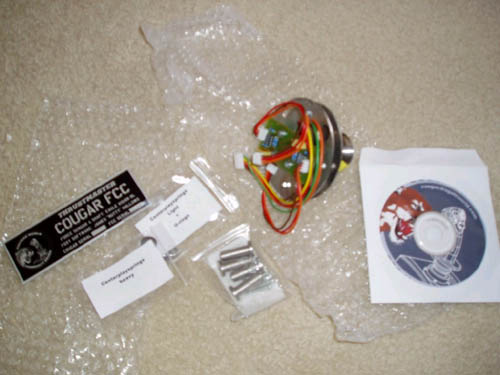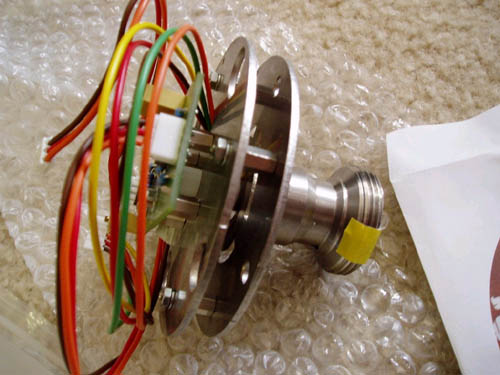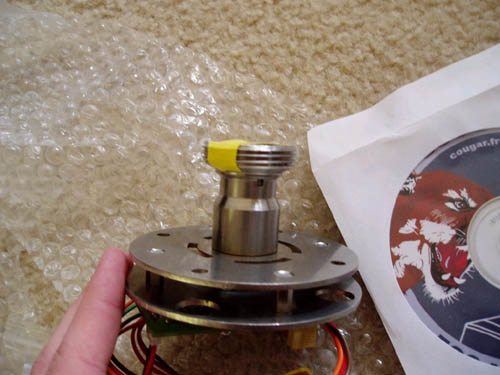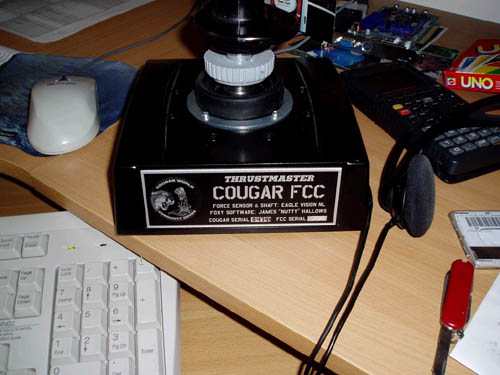|
Introduction
Greetings. Since there hasn’t been an end-user review of Eagle’s
new FCC mod, I thought I would write one and give some thoughts for anyone that
might be interested in purchasing one (or even the RealSimulator FSS for that
matter). Let’s get to it.

What is this "FCC" business?
What is the FCC? I’m not big on reinventing the wheel, so here it is
straight from the manual.
"The FCC is a drop-in replacement for the original, motion induced, Cougar
gimbals. The FCC uses strain gauges which translate the force applied to the
stick in a voltage that is applied to the original Cougar PCB. This means that,
unlike the original gimbals the output is only determined by the amount of force
you apply and is not related to the movement of the stick. This gives a completely
different feeling than the original gimbals and you have to get used to it.
This way it mimics the real F16 stick, which also is force-induced. In doing
so the FCC becomes far more precise than the original gimbals and responds much
faster than is possible with any potentiometer based joystick."

Why do we want a force induced stick?
The answer is quite simple—realism. Realism is what most everyone flying
combat simulations is aiming for—well, and fun of course. But with realism
comes more fun (to some J ). Here’s a short description of the real stick.
The F-16 sidestick controller is a force-sensing unit which contains transducers
in both pitch and roll axes and moves approximately ¼ inch in both axes.
Maximum noseup and nosedown pitch commands are generated by 25 and 16 pounds
of input, respectively. Roll commands are generated by a maximum of 17 pounds
in cruise gains and by 12 pounds in takeoff and landing gains.
Ok, we have the specs, now what? The Cougar is a GREAT stick, no matter what
configuration it is in and the thought of flying without one disturbs me, but
it failed pretty miserably with its gimbaled system. It is manufactured in poor
quality metal, develops huge gaps of "play" over time as the metal
wears down and it is simply not a true force stick.
Not only does the FCC replicate the real stick in feel, it also does something
that the Cougar community has been trying to eliminate from day one—center
play and the build up of it. There are some other great modifications out there
that do this, but the FCC takes it much further. The FCC takes all the slop
away, and gives us a great representation of the real stick. Assuming you have
the energy to do it, constant force equals constant G. With the old gimbals,
it is too easy to move the stick a little bit and lose the effect. A big thing
the stock gimbals lacked was the feeling of "stability" of the F-16.
Many people shaped their axis curves in order to make the movement less which
yielded a very unrealistic feel in sensitivity and stability. The default axis
shape, although also unrealistic had the best feel of stability. This concern
is completely gone.
The fact is with the FCC, one feels connected to the jet--even if it’s
an aircraft that doesn’t have a force-induced stick. You get "jet
hydraulic flight controls-like" feeling because you are no longer dealing
with stick displacement, but rather specific stick force.

I’ve had the privilege of being able to spend around 6 hours goofing
around in both the latest BLK 30 (Charlie Plus) and BLK 42 UDTs (Unit Training
Device, i.e., simulator—the Air Force always comes up with clever acronyms
;-) I can positively say the FCC feels VERY close to the real sim. I am extremely
pleased with it and hope to get back in the sim to do some more comparing.
How much force does the FCC require? What if I don’t have a homebuilt
cockpit to mount it in?
No problem! The FCC comes with 3 sets of "spring" washers that you
choose how much resistance you want. There are light+rubber o-ring, light, and
heavy springs. If you want no movement, you can simply not install the washers.
I liked the heavy ones right off the bat and haven’t actually tried the
others. But the directional play is very, very small and feels pretty good comparing
with the real stick. Your arm does get tired after a while with the heavy springs
if you’re yankin’ and bankin’, which is also true of the real
stick, until you build up your forearm and get used to it. A big factor in deciding
which springs you want to choose is how your stick is mounted, if at all. If
you’re going to use heavy springs and have your stick on your desk, you
will at the minimum need to use some pretty heavy duty velcro, a c-clamp or
some other means of securing the base. The other lighter options may need some
securing as well.
If you’re a cockpit builder and have the means for securing the stick
in its proper place (near your side and with the proper tilt forward), then
I’d suggest using the heavy springs minimum for sure—maybe even
none. I haven’t been too concerned with the actual forces required yet,
because my stick is velcroed to the desk. I hope to build a special mount at
my side at some point. Most users won’t be concerned with the actual forces
required, but rather just the feel of it.
The FCC manual has plenty of information regarding how you might want your
stick to feel given your mounting configuration and preferences so I won’t
repeat them here.
Is it hard to install?
No, it was very easy to install. Even the "mechanically challenged"
should be able to install it. It goes without saying, but just follow the instructions.
They are very well written and include large pictures to ease understanding.
The manual is in PDF format on an included CD. Also on the CD is an electronic
calibration guide and a general guide to calibrating the Cougar. The electronic
calibration guide is just for if there’s a difference in your Cougar base
and you realize that the forces required are not the same in all directions.
This is a normal occurrence from Cougar base to Cougar base. Electronic calibration
has nothing to do with the Cougar’s calibration.
Another thing the manual also mentions that deals with installation is the
shaft that goes into the stick. I found that after installation, there was a
very small amount of play in the Y-axis. It was due to a couple of screws in
stick handle being a little loose and thus the shaft (not the FCC shaft) and
stick handle weren’t tight. I also took the handle apart and found there
is another small screw down near the stick base inside the stick that works
in conjunction with the lowest screw in the handle that helps clamp the stick
shaft into the stick. It was also loose. This problem had nothing to do with
the FCC—just another Cougar design flaw. If it becomes loose again, I’ll
have to further investigate a better solution.

Conclusion
I recommend this mod 100% if you’re able to afford it. The
design is very clever. It combines neat engineering, high quality parts and
a very obvious attention to detail. The feel is indescribable. Precision input
events like refueling are a breeze. Manual ILS approaches in FS 2004 are a piece
of cake. Also available is the RealSimulator FSS, which is very similar to the
FCC. It also looks VERY promising. I recommend reading all you can find about
both before deciding which one you want to buy. I don’t think you’d
make a mistake picking one over the other--at least not at this point. I went
with the FCC because the design was finalized, beta testing was over and it
was available. Happy flying, at least for me. ;-)
Mirv
|